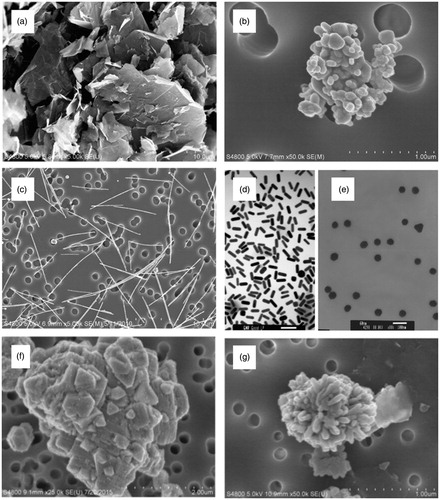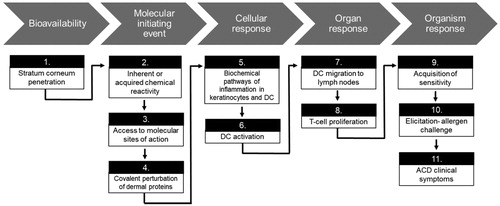Figures & data
Figure 1. Different morphologies of nanomaterials are shown: (a) graphene sheets, (b) silver nanoparticles, (c) silver nanowires, (d) gold nanorods, (e) gold nanoparticles, (f) nickel oxide nanoparticles, and (g) copper oxide nanoparticles.

Table 1. Metal nanomaterial production rates and corresponding applications.
Figure 2. Steps of the Adverse Outcome Pathway (AOP) for dermal sensitization adapted from the Organization for Economic Cooperation and Development (OECD).

Figure 3. Potential adverse outcomes with respect to the sensitization and elicitation phases of allergy following exposure to immunotoxic agents. Adjuvant effects resulting from exposure prior to allergen sensitization can manifest as increased susceptibility to sensitization. Exposure concurrent to sensitization may lower the threshold of allergen exposure required to induce sensitization. Following sensitization to allergen, exposure to an immunotoxic agent either in the absence or presence of allergen may result in a lower threshold of exposure required to induce elicitation reactions or increased severity of elicitation symptoms. These effects may further increase susceptibility to elicitation reactions as result of physiological alterations such as compromised skin barrier integrity. Furthermore, isolated exposure to immunotoxic agents or concurrent to allergens in established allergic disease conditions may also contribute to the progression of chronic effects, such as airway remodeling, which can also further contribute to elicitation reactions.

Table 2. Summary of major findings from studies characterizing the effect of metal nanomaterials on dermal allergy grouped by metal.
Table 3. Summary of major findings from studies comparing the effects of various physicochemical properties of metal nanomaterials on dermal allergy grouped by property of interest.
Table 4. Metal nanomaterials and corresponding physicochemical properties shown to influence immunological processes involved in the development and augmentation of ACD.
Table 5. Summary of major findings from studies characterizing the effect of metal nanomaterials on respiratory allergy grouped by metal.
Table 6. Summary of major findings from studies comparing the effects of various physicochemical properties of metal nanomaterials on respiratory allergy grouped by property of interest.
Table 7. Metal nanomaterials and corresponding physicochemical properties shown to influence immunological processes involved in the development and augmentation of asthma.
